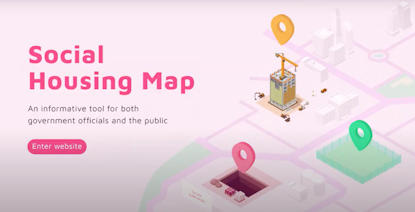Mapping for better social housing in Taiwan

Open Contracting Partnership worked with the Presidency of Taiwan to hold an international hackathon, inviting participants from around the world to propose open data solutions for delivering the Sustainable Development Goals. We were impressed with the smart and innovative work produced and are proud to feature the top teams’ projects in this blog series. Learning Man recounts how the Social Housing Map came into existence and what the next steps are to strengthen open contracting in social housing.
The success of social housing is an important way to achieve a sustainable city and provide affordable housing for everyone in Taiwan. Social housing helps economically disadvantaged groups – such as single parents, those with disabilities, and senior citizens – to enter the housing market.
The government of Taiwan, a country of just over 23 million people, has an ambitious policy that aims to make 200,000 new social housing units available in under a decade. It plans to build 120,000 new apartments, provide 80,000 units subleased from private owners or managed on their behalf, and offer floor-area ratio bonuses to increase housing offers. While the government has already provided tens of thousands of new apartments in recent years, there remains an urgent need for social housing in Taiwan.
Our work at Learning Man facilitates a better procurement environment by making social housing procurement data more accessible and easier to analyze and understand.
Our team of five – three engineers, a lawyer, and a designer – worked tirelessly to develop knowledge, communicate with stakeholders, and build the backend for our platform. In an initial research phase through calls and emails, we were able to piece together the larger picture of social housing in Taiwan. Throughout we worked with stakeholders to address any legal or logistical issues. The end result was our Social Housing Map platform, which connects government agencies and rental agents to potential social housing tenants.
We have built a data pipeline that automatically collects social housing procurement data and converts it into the Open Contracting Data Standard (OCDS) format – a global best practice schema that guides what information to publish from planning to implementation of the public procurement process. Our project essentially combines social housing procurement data from Taiwanese counties with detailed geographical mapping to analyze and show insights on social housing in Taiwan.
Converting all data into the OCDS format was vital to make the Social Housing Map project possible. Since each social housing project might have multiple procurements, we also incorporated the Open Contracting for Infrastructure Data Standard to increase the amount of information published.
We use the OCDS/OC4IDS procurement data to join up all procurement information on multiple social housing projects, visualize projects with geographic data on the map, and build a dashboard with analyzed indicators to provide insights in our website. The OCDS comes with certain predefined indicators to evaluate the overall health of the procurement environment: after transforming data into the OCDS format, we can immediately know how to calculate and share those indicators. The open contracting method has helped us save time and calculate all the metrics involved in Taiwan’s social housing procurement.
In the next phase, we will link the social housing data to data that can help us understand some of the other social housing-related issues that are affecting Taiwanese communities. This will help us answer questions like: “Has the social housing project helped the economy? Has it helped raise birth rates?” Most of all the project will create more transparency and help the government to be more accountable. We believe it contributes towards the Sustainable Development Goal of sustainable cities and communities: cities should be “inclusive, safe, resilient and sustainable”.
One of the next challenges we will tackle will be how to integrate and unify the social housing management system and strengthen the monitoring phase of the open contracting project. This goes beyond the procurement and contracting phases and extends to everything after people move into social housing apartments. For example, we’d like to include construction progress reports by onboarding construction companies to collaborate and submit them. These vendors are already providing status updates to the local and central government. By integrating them into our system, we can create a more efficient government reducing the reporting delay. We also want to integrate environmental indicators.
We believe in open data and open procurement: that is why we will try to scale up the impact of our project by collaborating with Taiwan’s e-procurement website, the Public Construction Commission – which oversees public procurement in Taiwan (with 38 procurement supervision units across the country) – to make all procurement data, not limited to social housing, available in the OCDS format on its website.
By providing more open data and analysis of the social housing market, we can make it more transparent, reliable, and needs-oriented, and make the Social Housing Map a key factor to building a sustainable city.
